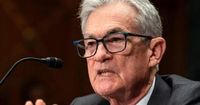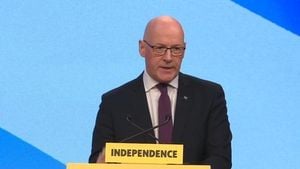When Federal Reserve Chair Jerome Powell steps up to the podium at the Jackson Hole economic symposium this Friday, all eyes—on Wall Street, in Washington, and around the world—will be fixed on what he says next. The annual gathering in Wyoming, hosted by the Federal Reserve Bank of Kansas City, has long been a stage for central bankers to unveil their thinking, but this year’s event is freighted with more tension than usual. With President Donald Trump openly pressuring the Fed to cut interest rates and even calling for resignations, Powell faces a test not just of monetary policy, but of the very independence of America’s central bank.
This year’s Jackson Hole theme, “Labor Markets in Transition: Demographics, Productivity, and Macroeconomic Policy,” couldn’t be more apt. The U.S. economy is flashing mixed signals: job growth has slowed, inflation is on the rise, and investors are betting—some would say hoping—that Powell will hint at a rate cut in September. According to CBS MoneyWatch, investors are pricing in an 88% chance of a 0.25 percentage-point cut at the Fed’s next meeting, scheduled for September 16-17. But with inflation running at 3.1% year-over-year, well above the Fed’s 2% target, Powell is caught in a classic central banker’s bind: cut rates to boost a sluggish job market, or hold steady to keep inflation from spiraling?
President Trump, never one to shy from a fight, has turned up the heat. On August 21, 2025, he publicly demanded the resignation of Fed governor Lisa Cook over a mortgage fraud allegation—a charge she flatly denied, vowing not to be “bullied” out of her post, according to the Associated Press. Trump has also threatened to fire Powell himself, lambasting him for refusing to cut rates and even accusing him of mishandling a $2.5 billion renovation of the Fed’s headquarters. Economists have dismissed the latter charge as political theater, but the message is clear: Trump wants cheaper borrowing costs, and he wants them now.
Powell’s term as chair runs until May 2026, so he’s not going anywhere soon—at least, not without a legal battle. As AP reports, legal experts agree that the president cannot fire the Fed chair for mere policy disagreements; removal would require “cause,” such as misconduct or negligence. Any attempt to oust Powell would almost certainly end up in court and could send shockwaves through global markets. Still, Trump’s public pressure campaign is unprecedented in its intensity, reviving a debate that stretches back decades: why is the Fed insulated from direct White House control?
History offers a cautionary tale. In the 1970s, then-Fed Chair Arthur Burns, under pressure from President Richard Nixon, kept interest rates low ahead of the 1972 election. The result? Inflation soared, and the U.S. economy suffered years of pain. It wasn’t until Paul Volcker took the reins in 1979—appointed by President Jimmy Carter—that the Fed imposed sky-high rates, triggering a deep recession but ultimately taming inflation. Volcker’s stand is now seen as a defining moment for central bank independence, and a key reason why markets today prize that independence so highly.
So what can Powell say at Jackson Hole? According to CBS MoneyWatch, he’s likely to maintain a “wait and see” approach, emphasizing that the Fed remains data-dependent and will assess incoming economic reports before making any moves. “He has to signal, ‘We’re still data-dependent and we’ll see what the data tells us,’ so the Fed doesn’t get pushed into a corner,” said Mike Sanders, head of fixed income at Madison Investments. The Labor Department’s next jobs report and the Consumer Price Index, both due before the September meeting, will be critical in shaping the Fed’s decision.
But the pressure isn’t just political. The July jobs report showed weaker-than-expected hiring, raising fears that the labor market’s long run of strength may be fading. At the same time, inflation has ticked higher, driven in part by tariffs imposed by the Trump administration. As Will Denyer, chief U.S. economist at Gavekal Research, put it in a recent report, “Data alone suggests a rising risk of a stagflationary scenario, which is, you know, a Fed nightmare. That puts them in a bind between their two mandates being in conflict.”
The Fed’s so-called dual mandate—maximize employment while keeping inflation low—often requires walking a tightrope. Lowering interest rates can boost job growth but risks higher prices; raising rates can tamp down inflation but may choke off hiring. “The dilemma that the Fed is in has become, if anything, more intense,” said David Wilcox, a former Fed economist now at the Peterson Institute, as quoted by AP.
Wall Street, meanwhile, is hanging on every word. According to the CME Group’s FedWatch tool, markets were pricing in an 83% chance of a rate cut in September as of August 18, 2025. But not all economists are convinced a cut is imminent. John Ryding and Conrad DeQuadros of Brean Capital Markets wrote, “Powell may not want to say that a cut is off the table on September 17, but he needs to say something like: ‘At this point, there are some discomforting readings on inflation that are inconsistent with the attainment of the 2% inflation target and based on the evidence to date, I am not inclined to support a rate cut at the next FOMC meeting.’”
One thing is certain: Powell’s words will be parsed for any hint of a shift. He’s used the Jackson Hole stage before to signal major changes—in 2024, for instance, he confirmed the Fed was about to cut rates for the first time since the pandemic. This year, though, the signals are murkier. UBS economists led by Jonathan Pingle expect Powell to stay noncommittal: “We doubt he commits to a September rate cut specifically.”
For Powell, the stakes are as much institutional as they are economic. The Fed’s credibility rests on its willingness to make tough, sometimes unpopular decisions—raising rates when needed, even if politicians clamor for easy money. Congress gave the Fed its dual mandate in 1977 and requires the chair to testify twice a year, but day-to-day decisions are meant to be insulated from political winds. Still, the president appoints all seven members of the Fed’s Board of Governors, and over time, can shape its direction.
As the world tunes in to the Kansas City Fed’s YouTube channel at 10 a.m. Eastern Time, the question remains: will Powell bend to political pressure, or hold the line for central bank independence? For now, the answer seems to be a careful balancing act—one that could define his legacy and the Fed’s for years to come.




